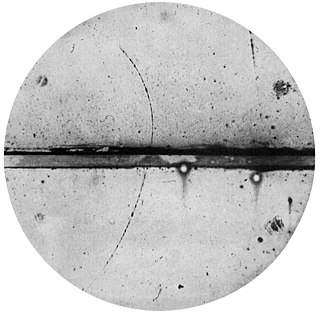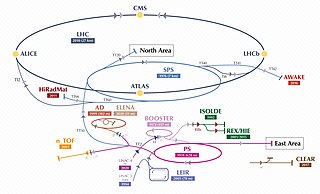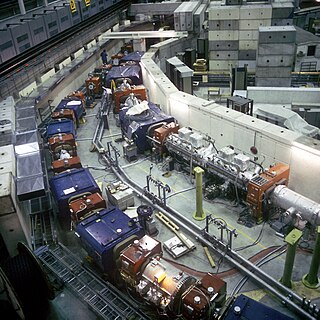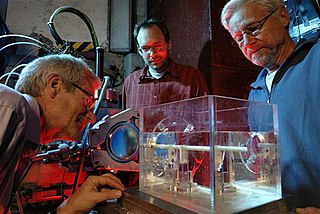
In modern physics, antimatter is defined as matter composed of the antiparticles of the corresponding particles in "ordinary" matter. Miniscule numbers of antiparticles are generated daily at particle accelerators—total artificial production has been only a few nanograms—and in natural processes like cosmic ray collisions and some types of radioactive decay, but only a tiny fraction of these have successfully been bound together in experiments to form antiatoms. No macroscopic amount of antimatter has ever been assembled due to the extreme cost and difficulty of production and handling.

The European Organization for Nuclear Research, known as CERN, is a European research organization that operates the largest particle physics laboratory in the world. Established in 1954, the organization is based in a northwest suburb of Geneva on the Franco-Swiss border and has 23 member states. Israel is the only non-European country granted full membership. CERN is an official United Nations Observer.

The Tevatron was a circular particle accelerator in the United States, at the Fermi National Accelerator Laboratory, east of Batavia, Illinois, and is the second highest energy particle collider ever built, after the Large Hadron Collider (LHC) of the European Organization for Nuclear Research (CERN) near Geneva, Switzerland. The Tevatron was a synchrotron that accelerated protons and antiprotons in a 6.28 km (3.90 mi) ring to energies of up to 1 TeV, hence its name. The Tevatron was completed in 1983 at a cost of $120 million and significant upgrade investments were made during its active years of 1983–2011.
ATHENA, also known as the AD-1 experiment, was an antimatter research project at the Antiproton Decelerator at CERN, Geneva. In August 2002, it was the first experiment to produce 50,000 low-energy antihydrogen atoms, as reported in Nature. In 2005, ATHENA was disbanded and many of the former members of the research team worked on the subsequent ALPHA experiment.

The ISR was a particle accelerator at CERN. It was the world's first hadron collider, and ran from 1971 to 1984, with a maximum center of mass energy of 62 GeV. From its initial startup, the collider itself had the capability to produce particles like the J/ψ and the upsilon, as well as observable jet structure; however, the particle detector experiments were not configured to observe events with large momentum transverse to the beamline, leaving these discoveries to be made at other experiments in the mid-1970s. Nevertheless, the construction of the ISR involved many advances in accelerator physics, including the first use of stochastic cooling, and it held the record for luminosity at a hadron collider until surpassed by the Tevatron in 2004.

The Proton Synchrotron is a particle accelerator at CERN. It is CERN's first synchrotron, beginning its operation in 1959. For a brief period the PS was the world's highest energy particle accelerator. It has since served as a pre-accelerator for the Intersecting Storage Rings (ISR) and the Super Proton Synchrotron (SPS), and is currently part of the Large Hadron Collider (LHC) accelerator complex. In addition to protons, PS has accelerated alpha particles, oxygen and sulfur nuclei, electrons, positrons, and antiprotons.

The Antiproton Decelerator (AD) is a storage ring at the CERN laboratory near Geneva. It was built from the Antiproton Collector (AC) to be a successor to the Low Energy Antiproton Ring (LEAR) and started operation in the year 2000. Antiprotons are created by impinging a proton beam from the Proton Synchrotron on a metal target. The AD decelerates the resultant antiprotons to an energy of 5.3 MeV, which are then ejected to one of several connected experiments.

A particle accelerator is a machine that uses electromagnetic fields to propel charged particles to very high speeds and energies, and to contain them in well-defined beams.
The Low Energy Anti-Proton Ring (LEAR) was a particle accelerator at CERN which operated from 1982 until 1996. The ring was designed to decelerate and store antiprotons, to study the properties of antimatter and to create atoms of antihydrogen. Antiprotons for the ring were created by the CERN Proton Synchrotron via the Antiproton Collector and the Antiproton Accumulator. The creation of at least 9 atoms of antihydrogen were confirmed by the PS210 experiment in 1995.
Atomic Spectroscopy and Collisions Using Slow Antiprotons (ASACUSA), AD-3, is an experiment at the Antiproton Decelerator (AD) at CERN. The experiment was proposed in 1997, started collecting data in 2002 by using the antiprotons beams from the AD, and will continue in future under the AD and ELENA decelerator facility.

The Low Energy Ion Ring (LEIR) is a particle accelerator at CERN used to accelerate ions from the LINAC 3 to the Proton Synchrotron (PS) to provide ions for collisions within the Large Hadron Collider (LHC).

The Antiproton Collector (AC) was part of the antiparticle factory at CERN designed to decelerate and store antimatter, to study the properties of antimatter and to create atoms of antihydrogen. It was built in 1986 around the existing Antiproton Accumulator (AA) to improve the antiproton production by a factor of 10. Together, the Antiproton Collector and the Antiproton Accumulator formed the so-called Antiproton Accumulator Complex (AAC).

The Antiproton Accumulator (AA) was an infrastructure connected to the Proton–Antiproton Collider – a modification of the Super Proton Synchrotron (SPS) – at CERN. The AA was built in 1979 and 1980, for the production and accumulation of antiprotons. In the SppS the antiprotons were made to collide with protons, achieving collisions at a center of mass energy of app. 540 GeV. Several experiments recorded data from the collisions, most notably the UA1 and UA2 experiment, where the W and Z bosons were discovered in 1983.
CTF3 was an electron accelerator facility built at CERN with the aim of demonstrating the key concepts of the Compact Linear Collider accelerator. The facility consisted in two electron beamlines to mimic the functionalities of the CLIC Drive Beam and Main Beam.

The Antiproton Cell Experiment (ACE), AD-4, at the Antiproton Decelerator facility at CERN, Geneva, was started in 2003. It aims to assess fully the effectiveness and suitability of antiprotons for cancer therapy.

The Antihydrogen Laser Physics Apparatus (ALPHA), also known as AD-5, is an experiment at the Antiproton Decelerator at CERN, designed to trap neutral antihydrogen in a magnetic trap, and conduct experiments on them. The ultimate goal of this experiment is to test CPT symmetry through comparison of the atomic spectra of hydrogen and antihydrogen. The ALPHA collaboration consists of some former members of the ATHENA collaboration or AD-1 experiment, as well as a number of new members.
AEgIS, AD-6, is an experiment at the Antiproton Decelerator facility at CERN. Its primary goal is to measure directly the effect of Earth's gravitational field on antihydrogen atoms with significant precision. Indirect bounds that assume the validity of, for example, the universality of free fall, the Weak Equivalence Principle or CPT symmetry also in the case of antimatter constrain an anomalous gravitational behavior to a level where only precision measurements can provide answers. Vice versa, antimatter experiments with sufficient precision are essential to validate these fundamental assumptions. AEgIS was originally proposed in 2007. Construction of the main apparatus was completed in 2012. Since 2014, two laser systems with tunable wavelengths and synchronized to the nanosecond for specific atomic excitation have been successfully commissioned.

GBAR, AD-7 experiment, is a multinational collaboration at the Antiproton Decelerator of CERN.

The Super Proton–Antiproton Synchrotron was a particle accelerator that operated at CERN from 1981 to 1991. To operate as a proton-antiproton collider the Super Proton Synchrotron (SPS) underwent substantial modifications, altering it from a one beam synchrotron to a two-beam collider. The main experiments at the accelerator were UA1 and UA2, where the W and Z boson were discovered in 1983. Carlo Rubbia and Simon van der Meer received the 1984 Nobel Prize in Physics for their decisive contribution to the SppS-project, which led to the discovery of the W and Z bosons. Other experiments conducted at the SppS were UA4, UA5 and UA8.

The TRAP experiment, also known as PS196, operated at the Proton Synchrotron facility of the Low Energy Antiproton Ring (LEAR) at CERN, Geneva, from 1985 to 1996. Its main goal was to compare the mass of an antiproton and a proton by trapping these particles in the penning traps. The TRAP collaboration also measured and compared the charge-to-mass ratios of antiproton and proton. Although the data-taking period ended in 1996, the analysis of datasets continued until 2006.














